Introduction – Refrigerators Rank 7th In Biggest Home Electricity Use
[Update Jan 7th 2024: We re-examined the EnergyStar data and updated the table].
We recently reanalyzed our data and found that we have two new contenders. First we have a new top most efficient winner from LG, and second we have a new one in the 7th position from Arctic Wind. It’s not surprising that refrigerators and freezers, combined, are the 7th most electricity hungry appliances in a home. Here we take a look at the most energy efficient refrigerator.
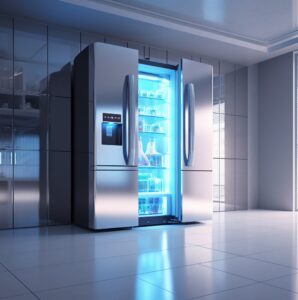
7 Most Energy Efficient Refrigerator 2024
Here we introduce the top 7 most energy-efficient refrigerators. See our table below if you’re interested in a side-by-side comparison.
1. LG LHTNS2403*
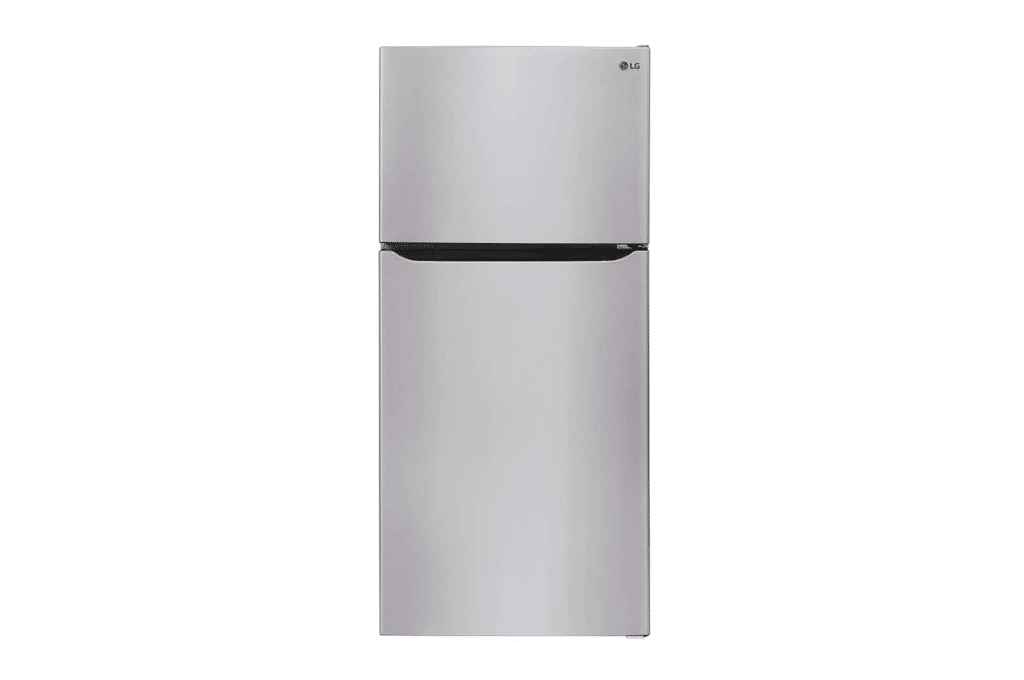
A new champion coming in at number 1 for efficiency is the LG LHTNS2403S. The truth is that it looks very similar to an older model that LG must have discontinued, the LRTLS2403* series which had very similar efficiency that’s 10% more energy efficient than the US Federal Standard.
It offers 23.8 cubic feet of storage space and demonstrates notable energy efficiency, consuming only 417 kWh per year. This translates to an exceptional 14.63 kWh per cubic foot, making it the most efficient model in its class on a kWh per cubic foot basis.
In terms of design, the LG LHTNS2403S features a modern aesthetic with clean lines and hidden hinges. The interior is illuminated by energy-saving LED lighting, and the unit includes digital temperature controls for maintaining optimal conditions. It’s also equipped with a quiet operation compressor, adding to its user-friendly attributes.
While the model boasts a spacious interior and versatile storage options, including humidity-controlled crispers for fruits and vegetables, it is important to note that these features are fairly standard in contemporary refrigerators.
The model’s true standout aspect is its energy efficiency, which is a significant factor for environmentally conscious consumers.
2. Samsung RF30BB6602**
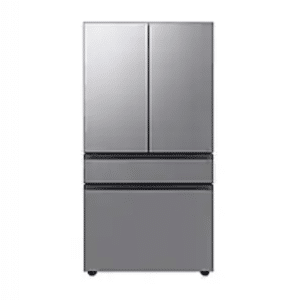
Samsung, a global leader in technology, has unveiled its new BESPOKE refrigerator line. On our list it is number 2, displacing GE from June 2023 with an efficiency of 14.77 kWh per cubic foot cooled.
These refrigerators come in a variety of models, each offering sophisticated temperature controls and customizable panels in a range of colors and finishes like Matte Black Steel and Navy Glass.
The 4-Door Flex model stands out with features like a Beverage Center with an AutoFill Water Pitcher, a Dual Ice Maker, and FlexZone technology that allows for up to five different temperature settings.
Other models in the BESPOKE line, such as the Flex Column and Bottom Freezer refrigerators, offer similar customization and advanced cooling features.
The series also includes specialized units like the Kimchi and Specialty Series Refrigerator, designed for precise cooling and fermentation.
For those looking for smart capabilities, the Family Hub models offer additional features like a built-in Dual Ice Maker and a FlexZone compartment.
3. GE GTE22JTN****

Coming in at number 3 is the GE’s GTE22JTN****, which is a line of refrigerators are some of the most efficient on the market, with an Energy Star rating of 2.0.
These fridges use an advanced cooling system and an automatic defrost cycle to keep your food fresh and your energy bills low.
It’s so close to the LG that we would say they’re identical in terms of total capacity and the amount of energy used per year. GE refrigerators have been around for over 100 years.
The first GE refrigerator was introduced in 1911. It was a wooden box that held ice and had a door that opened to the outside. The first GE refrigerators were not very popular and were only sold in a few stores.
In 1915, GE released a new model of refrigerator that was made of metal and had a glass door. This model was more popular and was sold in more stores.
4. Whirlpool WRT541SZD*0*

The Whirlpool refrigerator is a top freezer type that is ENERGY STAR certified. It uses 10% less energy than the US Federal Standard.
The refrigerator has a total volume of 21.3 cubic feet and is 64.8 inches tall and 32.5 inches wide. It has been available on the market as far back as September 3, 2014.
Whirlpool is one of the most popular appliance brands in the world and their refrigerators are no exception.
The history of Whirlpool refrigerators dates back to the early 20th century when the company was founded in 1911.
Since then, Whirlpool has been constantly innovating and improving their refrigerators to keep up with the changing needs of consumers.
One of the most notable innovations from Whirlpool is the introduction of the frost-free refrigerator in the 1950s.
This type of refrigerator eliminates the need for manual defrosting, which was a tedious and time-consuming task.
Frost-free refrigerators quickly became the standard in the industry and are still widely used today.
In the 1980s, Whirlpool introduced the side-by-side refrigerator, which became an instant hit with consumers. This type of refrigerator offers more space than traditional top-freezer models and is much more convenient to use.
Side-by-side refrigerators are still very popular today and are offered in a variety of sizes and designs.
5. Midea HD-774**
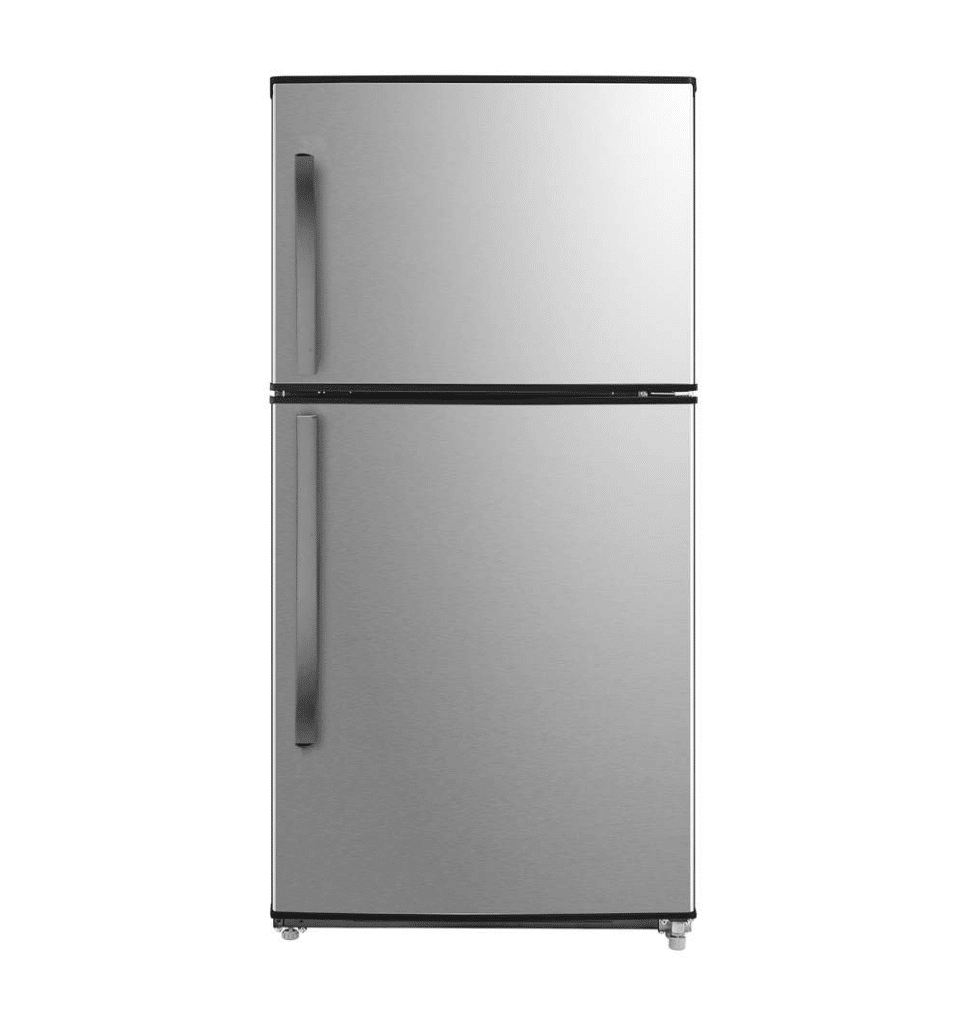
The Midea refrigerator is a top freezer model that has automatic defrost with top-mounted freezer without an automatic ice maker. The defrost is automatic. The dimensions are 67.0″ x 33.0″, with a capacity of 21.0 ft3. The adjusted volume is 25.6 ft3.
The estimated annual energy use is 394 kWh/yr. It is certified to meet ENERGY STAR Most Efficient 2022 criteria. The Midea refrigerator was first introduced in China in the early 1980s. It was designed as a low-cost alternative to the more expensive refrigerators that were available at the time.
The Midea refrigerator quickly became popular in China and other parts of Asia. In the early 1990s, the company began exporting its refrigerators to Europe and the United States. Today, Midea refrigerators are sold in more than 100 countries around the world.
6. Frigidaire FFHT2022A
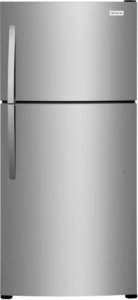
The Frigidaire 20.0 Cu. Ft. Top Freezer Refrigerator stands out as a highly efficient appliance, ranking as the sixth most efficient in cooling per kWh of electricity. Priced at $1,179.00, it offers a substantial 20 cubic feet of storage space, yet is designed to fit neatly into a standard 18 cu. ft. cutout, making it a versatile choice for various kitchen sizes.
This model is notable for its EvenTemp™ Cooling System, which ensures consistent temperature maintenance, crucial for food preservation. The refrigerator’s interior is thoughtfully designed, featuring spacious storage options including generous door bins and full-width glass freezer shelves.
Its stainless steel color adds a sleek, modern touch to kitchen aesthetics. Additionally, Frigidaire.com enhances the value of this refrigerator with perks like a price match guarantee, VIP customer support, and a 7-day money-back guarantee with free returns.
The dimensions of the refrigerator are 66 3/8 inches in height, 30 inches in width, and 32 inches in depth, making it the smallest of the ones we looked at.
7. Arctic Wind 2ATMSL212E
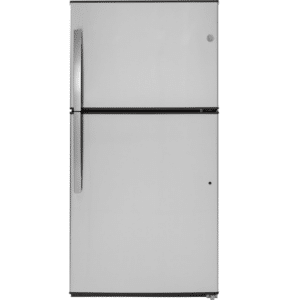
The Arctic Wind ATMSL212E stands out in its category, ranking as the 7th most efficient among 215 compared refrigerators when measuring energy efficiency on a kWh per cubic foot basis. This 33-inch freestanding top freezer refrigerator boasts a total capacity of 21.2 cubic feet, equipped with two glass shelves and a crisper drawer.
Designed with a right hinge and reversible doors, it offers flexibility in kitchen placement. Its stainless-look finish adds a contemporary touch to kitchen decor. Notably, this model features a frost-free defrost system, eliminating the need for manual defrosting.
Although not the top performer in energy efficiency, its position as the 7th in its category is commendable, especially considering it’s compared against a pool of 200 other refrigerators. Its energy efficiency rating of 15.40 kWh per cubic foot, while not the lowest, is still significant, especially when combined with its Energy Star certification. This certification underscores its eco-friendly operation and potential for cost savings in energy bills.
In summary, the Arctic Wind ATMSL212E offers a balanced combination of size, modern features, and relatively high energy efficiency, making it a suitable choice for those prioritizing both functionality and energy conservation in a refrigerator.
Methodology: We Analyzed 3,308 Refrigerators
We showed the top 7 from analyzing Energy Star certified home refrigerators. All except one are “top freezer” types with the freezer arranged to be on top. The new entrant Samsung is the only bottom freezer type. Here is a handy table that summarizes the above. Each refrigerator name is clickable and takes you to the review:
| Rank | Brand (Model) | Type | Capacity (Volume ft3) | Annual Energy Use (kWh) | kWh / year (per Cu ft) |
| 1 | LG LHTNS2403* | Top Freezer | 23.8 | 417 | 14.63 |
| 2 | Samsung RF30BB6602** | Bottom Freezer | 30.1 | 545 | 14.77 |
| 3 | GE GTE22JMN**** | Top Freezer | 21.9 | 405 | 15.00 |
| 4 | Whirlpool WRT541SZD*0* | Top Freezer | 21.3 | 399 | 15.35 |
| 5 | Midea HD-774** | Top Freezer | 21 | 394 | 15.39 |
| 6 | Frigidaire FFHT2022A | Top Freezer | 20 | 371 | 15.39 |
| 7 | Arctic Wind 2ATMSL212E | Top Freezer | 21.1 | 396 | 15.40 |
The key here is the energy usage per cubic foot in the last column, which should be as low as possible. One reader pointed out below in comments that we should be using Watts (though not per time as he suggests). However, most refrigerators are rated in terms of kWh over a year of use including EnergyStar the government accreditation system. We guess that this is because fridges stay on all the time not intermittently using electricity so a cost estimate based on a year usage is most reasonable.
Efficiency Of 215 Refrigerator Brands

In our analysis of 3,308 refrigerators, we came across 215 brands. The efficiency in kWh per Cubic Foot varied wildly, over a factor of 8 from lowest to highest. The distribution of efficiencies is given above.
You can see the LG and GE models on the far left, using about 15 kWh per cubic foot. Whereas on the far right are brands and models that use up over 120 kWh per cubic foot.
Note that the top 100 or so are all very similar, with good efficiencies of under 30 kWh used to cool per cubic foot and then there’s a rise of more inefficient refrigerators after that.
One of us owns a Bosch refrigerator at home and wondered where it lies – it’s at 26 kWh per cubic foot which puts it in the top 100. That makes it efficient, but not as efficient as the best LG and GE models! In fact, the LG and GE are 30% more efficient than the Bosch.
Efficiency Of The Top 25 Refrigerator Brands Are Very Similar
To give you a better sense of the top refrigerators, we plotted out the efficiencies of the top 25 which includes the top 7 we reviewed. One thing you’ll notice is that the efficiency isn’t much different from 1 to 25!
They are all similar. In terms of savings, you’ll save just a few percent comparing the first to the twentieth. This was hard to see in the table, that the differences are actually quite small. [Updated: Jan 7th 2024, we updated our analysis]

Refrigerators That Use The Least Energy – For Fun Only
We list here also the top refrigerators that use the least energy. If you take a look at them, they’re really not suitable for family use because they are really small and they’re incredibly inefficient.
In fact all of them are compact refrigerators. Their efficiency in terms of the electricity in kWh used to cool every cubic foot is pretty high, as much as 4 times higher.
The Goldstar compact is the closest in terms of efficiency and has the largest capacity of these compacts that looks similar to the efficient refrigerators we analyzed above.
| Brand Name | Model Number | Type | Capacity (Total Volume) (ft3) | Annual Energy Use (kWh/yr) | kWh per Cu ft |
| DOMETIC | C40S2 | Compact Refrigerator | 1.1 | 106 | 96.3636364 |
| Goldstar | GKIM08121* | Compact Refrigerator | 7.6 | 169 | 22.2368421 |
| Montgomery Ward | FR336-W-B-SSBLACK | Compact Refrigerator | 3.2 | 193 | 60.3125 |
| COCA COLA | CRF32CK | Compact Refrigerator | 3.2 | 197 | 61.5625 |
| FRIGIAIRE | EFR331 | Compact Refrigerator | 3.2 | 197 | 61.5625 |
| Char-Broil | A107-7000-9000 | Compact Refrigerator | 2.7 | 198 | 73.3333333 |
| Lynx | LN24DW* | Compact Refrigerator | 5 | 199 | 39.8 |
| Marvel | MPDR424-SS71A | Compact Refrigerator | 5 | 199 | 39.8 |
| EcoMax | EF-32199-B-2 | Compact Refrigerator | 3.2 | 199 | 62.1875 |
| MicroChill | MCH4G16 | Compact Refrigerator | 3.2 | 199 | 62.1875 |
Methodology: Problems With Electricity Usage To Measure Efficiency
Now that you’ve looked at the results, you might be interested with our methodology.
For clarity of analysis, we excluded appliances that were “coolers” or “freezer-only” and included only mixed refrigerator and freezer units (including top freezers, bottom freezers, side-by-side units or compact refrigerators.)
A simple way to look for an efficient refrigerator is to look for the amount of energy used, which is recorded as kilowatt hours per year. This is the electricity consumption to keep the refrigerator running for one year. This is the wrong way to do it.
Imagine you had a tiny fridge that has only one cubic foot of space and it costs 100 kWh per year to run. Would you consider that efficient compared to a fridge that’s 20 times larger and costs 4 times more energy? Maybe.
The point is that if you want a tiny energy usage, then its possible to achieve it by making a fridge that’s all but impossibly small to use for home. The numbers above are from two real fridges in our database!
Instead We Defined Efficiency As kWh Used To Cool Per Cubic Foot
Therefore we analyzed the efficiency of the refrigerator by calculating the energy used to cool each cubit foot of volume.
To account for the volume correctly, we used the reported “adjusted capacity”, which is slightly larger than the true capacity because each refrigerator was a combination of a regular fridge and a freezer section.
Since freezers require more energy to cool to lower temperatures, they are given a multiplicative factor to account for the increased requirements.
The less energy needed to cool down the volume the better. The results of the analysis yielded refrigerators that were big enough for home use.
We also included only one model from each brand to highlight the breadth of options. Many times very similar models of the same brand had exactly the same efficiency.
Here are the top ten. They include very well known brands such as LG, GE, Whirlpool, and also less well-known manufacturers Midea, Insignia, Appliance Basics, Sankey.
The ones that didn’t make our top 7 but are here in the top list were Avanti, Smad, and Arctic Wind.
The Thing To Consider Before Buying An Energy-Efficient Refrigerator
But just because a refrigerator has an EnergyStar label doesn’t mean it is energy efficient. You must research and compare different models to determine which is the most energy-efficient for your needs.
Some factors you should look at when comparing refrigerators include their size, how often they are opened, how well-insulated they are, and whether or not they have features like automatic defrosting or a cooling feature that allows you to adjust the temperature inside.
When shopping for an energy-efficient refrigerator, consider where you will place it in your home. If possible, choose a model with adjustable shelving so that you can customize the interior space to suit your needs.
When looking for an energy-efficient refrigerator, it is important to consider various factors. First and foremost, you should look at the size and capacity of the unit, as well as the available storage options.
In addition, you should pay attention to the cooling and freezing capabilities of the fridge, as well as any additional features or technology that may help to reduce your energy costs over time.
You should also consider whether the refrigerator is portable or built-in, as well as its overall design and aesthetics.
Finally, it is important to read reviews from other users to understand how reliable and durable each model is over time.
Conclusions On The Most Energy Efficient Refrigerator

In conclusion, energy-efficient refrigerators are a great choice for anyone looking to save on their monthly energy costs while still enjoying the reliable cooling performance.
Whether you’re looking for a small, portable unit or a spacious built-in model, there is an energy-efficient fridge that will meet your needs and budget.
Choosing the right refrigerator requires careful consideration of your needs and the various features available in different models.
With so many choices available today, it can be difficult to know where to start. By researching and considering all the factors involved, you can find the perfect energy-efficient refrigerator for your home or office.

Anne Lauer
Anna Lauer is a writer, gardener, and homesteader living in rural Wisconsin. She has written for Mother Earth News, Grit, and Hobby Farms magazines. Anna is writing a new book about growing your food for free and an ultimate guide to producing food at little to no cost. When she’s not writing or gardening, Anna enjoys spending time with her husband and two young daughters.

Whirlpool is Junk!? We have bought 1 Whirlpool French Door from Lowes in Jan. 2021. It stopped cooling in less than a week (Bad compressor). Lowe’s gave us a replacement; it lasted 18 months (another Bad Compressor).
whole article sucks…math doesnt math and no one really cares about kwh……we need watts every hour….that is what is useful…..sorry….didnt find it one bit helpful…looking for a lowest watt count per hour….that what all of us need to know…otherwise noone cares about the kwh usage period,dot,end of story
Hope you’re a troll, the alternatives are depressing. Watt per hour is meaningless in this context, it would describe how much the power draw changes per hour, not the energy consumed – which is listed in the penultimate column in the author’s tables.
As she points out, the refrigerator with the lowest energy consumption is only 1.1 ft3 in space, and very inefficient. If you are living off grid as I do, the total energy use of the refrigerator does need attention, since one is limited by the backup battery capacity, for instance.
Watts/hour is nonsense, watthours/hour is what you may need, conversion from the author’s data (kwh/year) is trivial